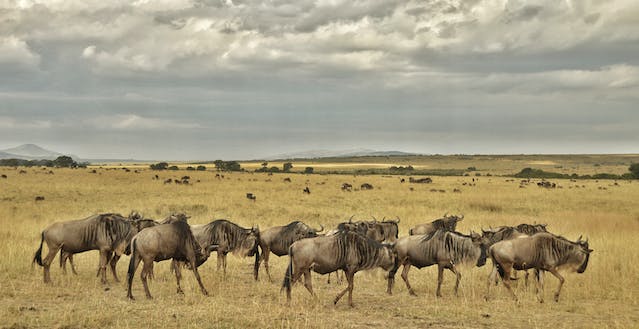The Great Wildebeest Migration is the huge annual movement of vast numbers of wildebeests together with zebras and gazelles to search for food and water between Tanzania and Kenya. The wildebeests travel from the Serengeti National Park in Tanzania to Maasai Mara National Park in Kenya from July to October. It is one of the New Seven Wonders of the World, also known as The World Cup of Wildlife.
Some people camp in the Maasai Mara wildlife reserve to witness the great wildebeest migration. However, their migration is somehow difficult to predict and people have different opinions on what month is best to view it. Their movements are always different and no two years have been the same. Some people say it can be based on the weather and the cycle of the seasons but there are no guarantees about it either.
Scientists and naturalists do not have clear explanations yet on how wildebeests know where they should go when they migrate but they have some theories. According to some scientists, wildebeests are enthused by the chemistry of the grass. They are attracted to higher levels of phosphorous and nitrogen that change when it rains. Meaning, they are following their taste when they migrate. However, some say that is can be just their instinct. Since some fossil evidence shows that wildebeests are roaming around Africa for over a million years, it can be an instinctive knowledge etched in their DNA to know which direction they should go.
In July, when the grass plains of the southernmost Serengeti begin to dry out, wildebeests migrate to search for greener nutrient-rich fields that will help sustain their next generations, even if it means causing death to many of their own as well. There is neither a start nor a finish to their search for food and water. Their migration includes crossing the Mara river where crocodiles are waiting to prey on them. Crossing this river is one of the highlights of their migration because they will try to cross it alive. Aside from the crocodiles, they are also being hunted by larger carnivores all throughout their migration. Crossing the Mara river is the last obstacle they have to go through to be able to reach the lush Maasai Mara grasslands. It takes them about three months to reach Maasai Mara.
When the rain begins to fall by late October, the wildebeests begin to head back south again. The tightly grouped herd will go through the eastern woodlands and some of the cows are heavy with the new season’s young. Once they reach the open plains of Serengeti, they will once again spread out and scatter. And the cycle of their migration goes on.
Interesting Facts About the Great Wildebeest Migration
- There are over 1.5 million wildebeests, 200,000 zebras, and a host of antelope traveling cross-country in the Great Migration.
- Half a million wildebeests are born each year in Serengeti, mostly between January and March. The month which has the highest calving rate is February where around 8,000 wildebeests are born each day. During the calving season, a host of predators such as lions, leopards, and hyenas are also around to take advantage of the easy prey.
- The Great Wildebeest Migration is considered as the largest overland migration in the world where animals travel a total of more than 800 kilometers during each cycle.
- If you’re wondering why wildebeests and zebras travel together in harmony, it is because they each eat different parts of the same kind of grass.
- Wildebeests have no natural leader. When they migrate, they split into smaller herds and circle the main mega-herd going to different directions. Their whole migration can cover up half of the whole Serengeti.
- The Serengeti National Park is the oldest eco-system on Earth. It contains a diversity of plants and animals that can’t be found in any place on the globe.
- Due to predation of carnivores, around 250,000 wildebeests, and 30,000 zebras are killed every year. Aside from predation, some of them die because of hunger, thirst, and exhaustion.
- Crocodiles can drown the wildebeests using their strong jaws to pull them down the water and break them off into pieces.
- More than 3,000 lions living in Serengeti stalk the wildebeests across the reserve during the Great Migration.
Wildebeests are amazing creatures. They are able to risk their lives going through months of exhausting migration to find food and water that will sustain their next generations.

